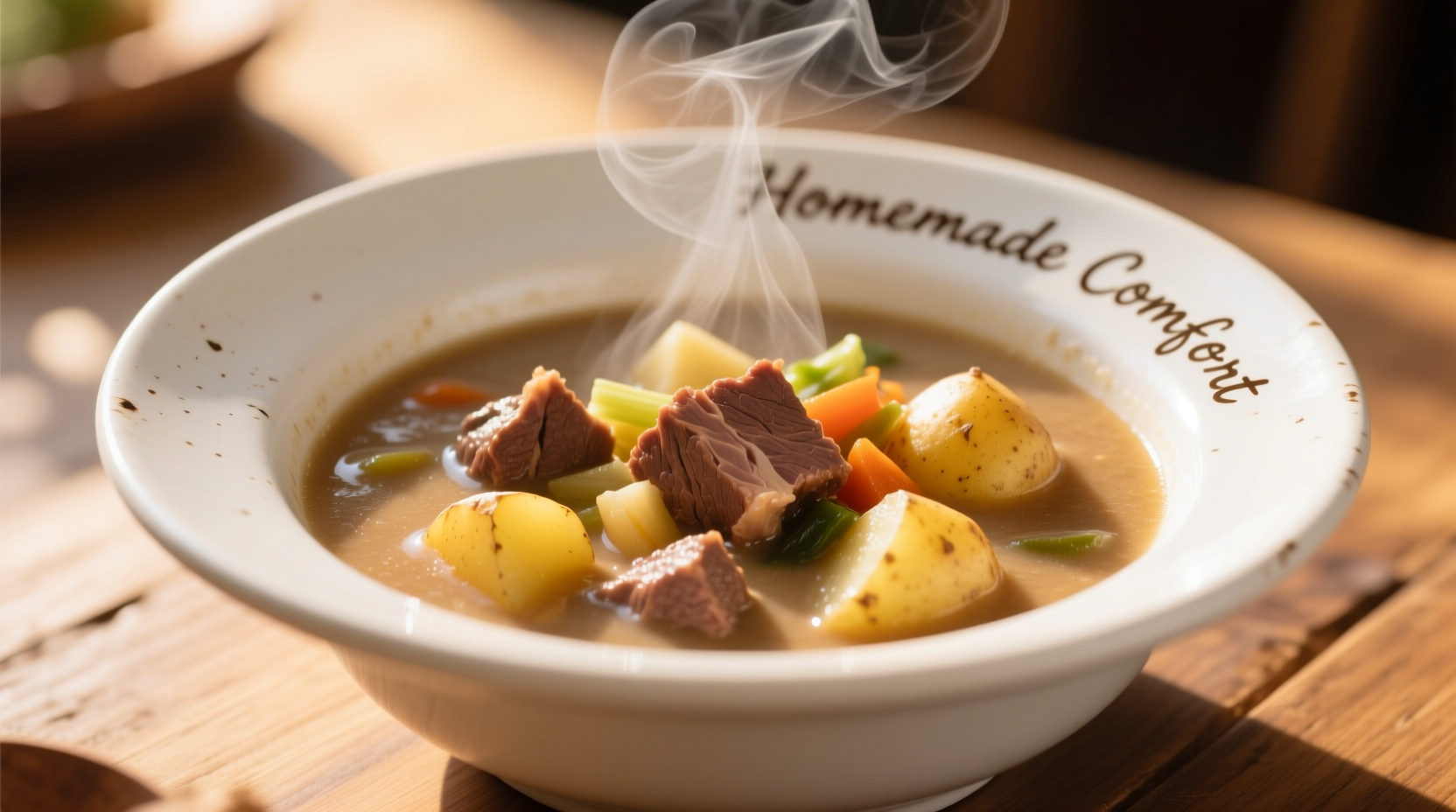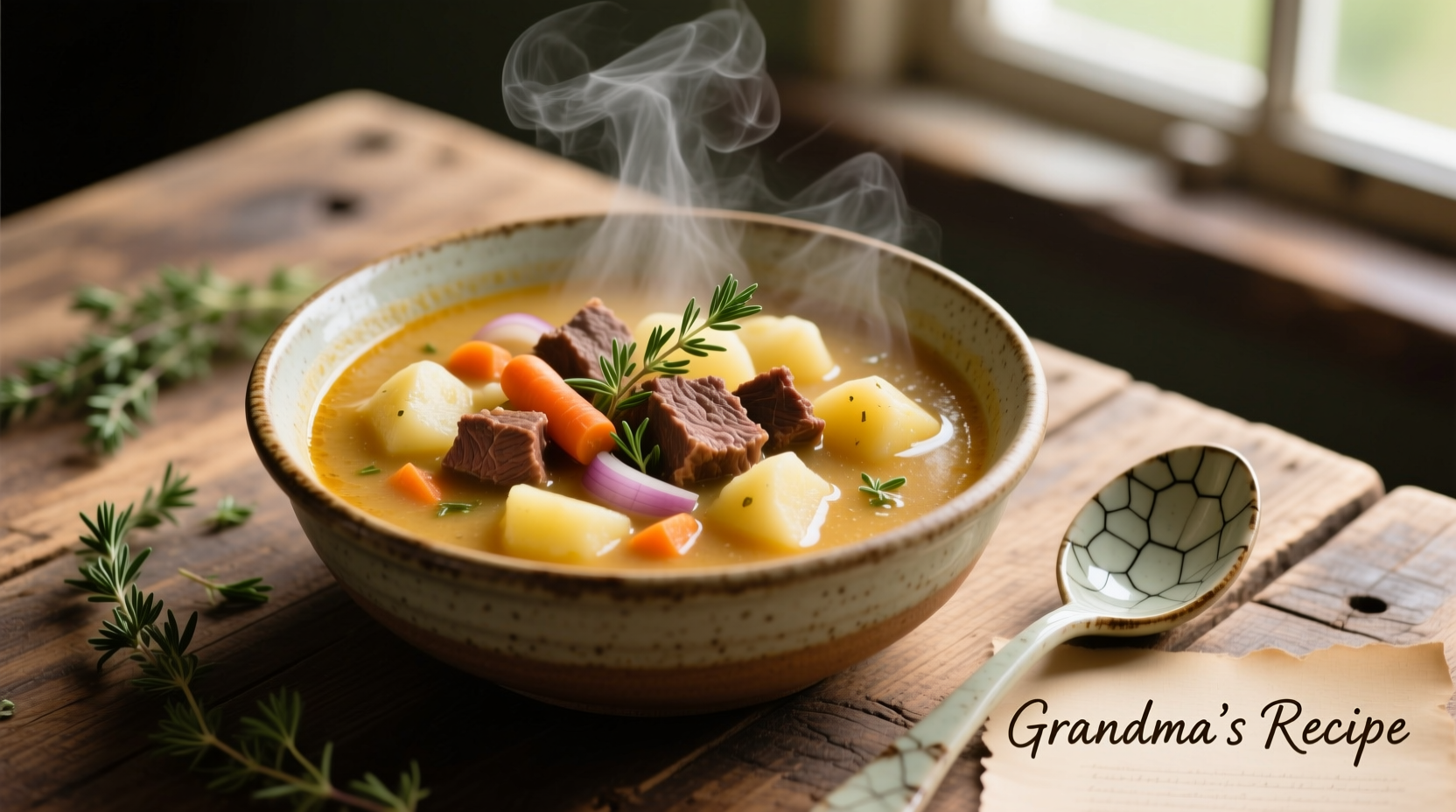Why This Potato Beef Soup Recipe Works Every Time
Nothing beats a steaming bowl of potato beef soup on a chilly day. As a chef who's perfected this classic dish in both professional kitchens and home settings, I've discovered the precise techniques that transform simple ingredients into extraordinary comfort food. This recipe delivers a rich, velvety texture without cream, deep beef flavor without hours of prep work, and perfectly tender potatoes that hold their shape.
Essential Ingredients for Authentic Flavor
The magic of potato beef soup lies in ingredient quality and proper proportions. Don't substitute haphazardly—each component plays a specific role in building complex flavors.
| Ingredient | Quantity | Why It Matters |
|---|---|---|
| Chuck roast (cut into 1-inch cubes) | 2 lbs | Marbling creates rich flavor; lean cuts become tough |
| Yukon Gold potatoes | 3 lbs | Natural buttery flavor and creamy texture when cooked |
| Yellow onions | 2 medium | Sweetness balances beef's richness |
| Carrots | 3 medium | Natural sweetness and color contrast |
| Celery | 3 stalks | Essential aromatic base for depth |
| Beef broth | 6 cups | Low-sodium allows flavor control |
Step-by-Step Cooking Process
Follow these professional techniques to achieve restaurant-quality results at home. The key is patience during the browning and simmering stages.
1. Proper Beef Browning Technique
Dry the beef cubes thoroughly with paper towels before seasoning with salt and pepper. Heat 2 tablespoons of oil in a heavy-bottomed pot over medium-high heat until shimmering. Working in batches to avoid crowding, sear the beef on all sides until deeply browned (about 3-4 minutes per side). This Maillard reaction creates complex flavor compounds essential for rich-tasting soup. Important food safety note: According to USDA guidelines, beef should reach an internal temperature of 145°F (63°C) with a 3-minute rest time for safety, though slow cooking in soup far exceeds this requirement.
2. Building Flavor Layers
After removing browned beef, add diced onions, carrots, and celery to the pot. Cook for 8-10 minutes until vegetables soften and develop fond (those browned bits on the bottom). Deglaze with 1 cup of broth, scraping up all flavorful bits. This technique, called fond recovery, captures maximum flavor that would otherwise be lost.
3. Perfect Potato Selection and Cutting
Yukon Gold potatoes maintain their structure better than Russets during long cooking. Cut into uniform 3/4-inch cubes to ensure even cooking. Add potatoes during the last 45 minutes of simmering to prevent them from becoming mushy. This timing detail makes the difference between perfect and disappointing potato texture.

Regional Variations Worth Trying
Potato beef soup has evolved differently across cultures. Understanding these variations helps you customize the recipe to your taste preferences.
| Regional Style | Key Differences | When to Choose This Version |
|---|---|---|
| New England Style | Includes corn and clam juice | For coastal flavor profiles in summer months |
| German Eintopf | Added sauerkraut and caraway seeds | When seeking tangy, complex flavor notes |
| American Midwest | Thickened with flour, includes green beans | For heartier, stick-to-your-ribs winter version |
Storage and Reheating Best Practices
Potato beef soup actually improves in flavor after 24 hours as ingredients meld. Store in airtight containers for up to 4 days in the refrigerator or freeze for up to 3 months. When reheating, add a splash of broth as potatoes absorb liquid during storage. Never microwave large portions—gentle stovetop reheating preserves texture. For frozen soup, thaw overnight in the refrigerator before reheating.
Common Mistakes to Avoid
Even experienced cooks make these critical errors that compromise soup quality:
- Boiling instead of simmering—vigorous boiling breaks down potatoes too quickly
- Adding potatoes too early—results in disintegrated potatoes by serving time
- Over-seasoning at the beginning—flavors concentrate as liquid reduces
- Skipping the resting period—soup needs 15 minutes off-heat for flavors to marry
Perfect Pairings for Your Potato Beef Soup
Elevate your meal with these professional pairing suggestions:
- Bread: Crusty sourdough or rye bread for dipping
- Salad: Simple arugula salad with lemon vinaigrette cuts richness
- Beverage: Medium-bodied red wine like Merlot or earthy stout beer
- Garnish: Fresh parsley and a dollop of horseradish cream
Frequently Asked Questions
Can I make potato beef soup in a slow cooker?
Yes, but with modifications. Brown the beef thoroughly first, then transfer to slow cooker with all ingredients except potatoes. Cook on low for 6-7 hours, adding potatoes during the last 2 hours. This prevents potatoes from becoming mushy while allowing beef to tenderize properly.
Why does my potato beef soup turn out watery?
Watery soup usually results from insufficient reduction or skipping the browning step. After simmering, remove 1-2 cups of broth, thicken with a cornstarch slurry (1 tablespoon cornstarch mixed with 2 tablespoons cold water), then return to pot. Alternatively, simmer uncovered for 15-20 minutes to reduce liquid naturally.
How can I make potato beef soup gluten-free?
Use cornstarch instead of flour for thickening, and ensure your broth is certified gluten-free. Many commercial broths contain gluten as a flavor enhancer. For authentic flavor without gluten, try blending 1 cup of cooked potatoes with 1 cup broth to create a natural thickener that enhances potato flavor.
What's the best cut of beef for potato soup?
Chuck roast is ideal due to its marbling and connective tissue that breaks down during slow cooking, creating rich flavor and tender texture. Avoid lean cuts like sirloin which become tough. For quicker cooking, consider short ribs which offer intense flavor but require slightly different timing.











 浙公网安备
33010002000092号
浙公网安备
33010002000092号 浙B2-20120091-4
浙B2-20120091-4